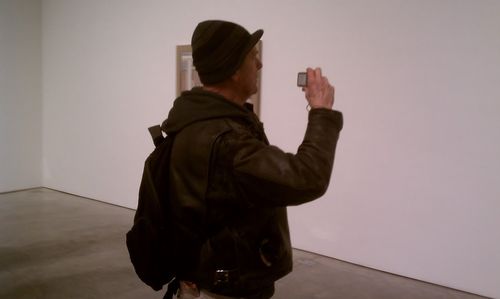
Munk recording "The James Kalm Report" at the opening of Joe Zucker's latest show
James writes:
"Do It Yourself" just did it.
Loren Munk, the apostle of DIY, whom I have written about in several columns this past year, gets his own Christmas Day profile in The New York Times in a piece by Jed Lipinski:
Several nights a week, he rides his mountain bike to art shows across the city from the 3,800-square-foot loft he shares with his wife in Red Hook, Brooklyn. His videos — recognizable for their unseen narrator’s labored breathing, jerky camera work and informed but uncritical commentary — run about 10 minutes and are shot with a tiny Canon Elph digital camera.
“There’s the great Chuck Close,” he said while filming a recent visit to Gavin Brown’s Enterprise gallery in Chelsea, before comparing the exhibiting artist’s technique to that of the post-painterly abstractionists.
“But he doesn’t just go to Chelsea,” said James Panero, an editor at The New Criterion, a conservative culture journal, who has written about Mr. Munk. “He goes to the most out-of-the-way places and treats them with the same level of importance. I think his videos will one day be in the Archives of American Art.”
Last February I predicted that 2011 would be "The Year of the Munk"--the time when Munk would rise to prominence for his work in the alternative art scene.
The year began with Munk's exhibition at Minus Space in Gowanus, reviewed here. The show featured paintings that chart Munk's idiosyncratic interpretations of art history.
Munk's understanding of history relates to the multidisiplinary approach of his artistic practice, which manages to combine painting, videography, writing, and (yes) biking. When I visited him in his Red Hook studio last January, he showed me a bumper sticker he had printed up (a few of them were used to hold his bike together). It said, "we are our own art history."
The statement goes to the heart of Munk's philosophy: that art-world outsiders, the vast "dark matter" of under-recognized artists like himself, need to write themselves into their own art history.
This principle energizes Munk's paintings, his criticism, his social commentary, and his new media project known as the James Kalm Report and James Kalm Rough Cuts--DIY videos of out-of-the-way galleries and artist studios to which he travels by bike. There are now nearly a thousand of his videos available for free online.
In September a solo exhibition of Munk's work, called "Location, Location, Location," went on view at Lesley Heller gallery. For Munk's first showing in a Manhattan venue in a decade, "Location" led me to consider the role of urban density in artistic innovation. Roberta Smith declared: "Mr. Munk gives dizzying visual expression to some of what lures the art-driven to the city: the sense of possibility in the air and of history beneath our feet." I agree.
Yet not everyone has praised Munk's paintings or his new-media work created under the James Kalm pseudonym. Charlie Finch and the Web 1.0 writers at artnet.com have gone after Munk (and myself). In one article, Finch declared Munk to be a "likeable, dimwitted observer who has recently emerged as the darling of the most reactionary element in art criticism, James Panero." Such denials only confirm the success of Munk's project.
This success means greater recognition for the alternative art scene that he has championed for decades. In 2011, Munk wrote the dark matter back into art history.